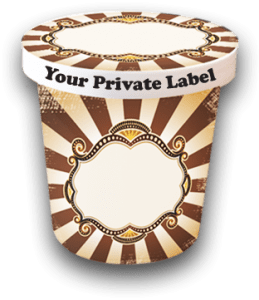The primary question I receive from individuals interested in private labeling a product starts like this: “I have invested a considerable amount of time and money into my project. How can I manufacture it and how do I get my “foot in the door” in retail sales.”
The answer I provide is usually surprising because it leads back to the inception of their idea, and in many cases, they find that they have placed the cart in front of the proverbial horse.
If you are interested in Private Labeling Your Product then read on.
Here are some of the basic steps I suggest you considered to insure overall success and guard against investing in a “white elephant.” These steps are designed as an overview, to cover a range of topics you need to be aware of. It is not intended to suggested that these are all of the tasks; they are simply an insight into key elements of private labeling a product.
Private Labeling Dairy and Non-Dairy Frozen Product
Step 1
Ask yourself:
- Why do you believe your idea is needed in the marketplace?
- Did people other than friends/family tell you that the product would be a hit?
- Have you seen a similar product offered anywhere else?
- Will the product make people fans of your brand?
- Is it an improvement on a product already in the marketplace or is it new?
Step 2
Formulate a strategy.
- Get familiar with the law and requirements of selling your product commercially.
- Find a graphic design service that can put your logo/concept to paper.
- Know if your product will perform the same when made on a larger scale.
- Determine the type of packaging you want to sell in.
- Identify if you want to primarily sell in the grocery store, vending cart, online, restaurant or stadium.
- Know what a buyer requires when approaching in any segment.
- Know the information required to print on a label, package and box.
- Know the estimated budget required in step 2.
Step 3
Act on the basics.
- Establish a company name.
- Create a NDA.
- Create a timeline to follow steps 2 & 3.
- Identify and secure a name, logo and color scheme.
- Investigate if the brand name or logo are already owned.
- Purchase a url and establish a email.
- Know the certifications affiliated with the product.
- Have a proven formula on paper.
Step 4
Understand manufacturing & logistic basics.
- Will product be made In-House or by Co-Packer?
- What equipment will be required in the manufacturing process?
- What are the core ingredients of the product?
- Does product need to be made in a specific region of the country?
- Legal requirements to produce for commercial sale?
- The difference between a frozen carrier and distributor?
- The storage temperature in a frozen warehouse?
- Investment required for any proprietary equipment, ingredients & packaging?
Step 5
Once you have a better grasp of the project, answer the following questions.
- How much time is allocated to first production?
- What is the maximum production capability on a daily, weekly or monthly basis?
- What happens if a customer is secured prior to first production?
- Will manufacturing be conducted in-house or outside?
- Who is responsible to order ingredients if Co-Pack is involved?
- What is a realistic lead-time from PO to delivery?
- What is the type of insurance and license necessary to carry?
- What is the budget investment required for first production, transportation and marketing?
Final Step
By the time you get here, you should be better equipped with a better understanding of scope of your project. Additional items will pop up that you will have to address along the way, but that is simply part of the process.
If you find that you need assistance with any steps along the way, Darryl can help, give him a call.
- Ethics In Using Madagascar Vanilla - November 21, 2023
- Money To Start Your Business - July 9, 2023
- Top 25 Common Myths About Ice Cream Co-Pack Manufacturers - April 22, 2023

